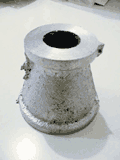|
|
Wenig burner Last updated: 05 Dec 2016 |
While in a "burner making" frame of mind, it seemed like a good idea to supplement the Oliver Upwind Burner with something a little larger for melting cast iron.
Looks like the Monster Burner based on the Reil burners by Rupert Wenig will fit the bill, as the propane regulator I have will go up to 2 bar. Check my mistakes below and you will see that it ended by being a "Baby Monster Burner"...
 |
28-Aug-2002: The casting for the reducer. You can click
here to see more details on how it was made.
This casting is not going to win a beauty contest but it will do the job. |
| Update 30-Aug-2002: What a mess... I found out that 1.1/4" pipe means bore size, not overall diameter. This is not going to work out as a Monster Burner in a million years. However, I can cut the burner tube down from 12" to 9-9.5" in length and the proportions should work out about right. Saves throwing the new casting away. | |
 |
Update 31-Aug-2002: There are two castings on the end of the bell housing, the first has some rough cutouts to allow the air intake to be choked. The two end castings were made simply by pushing a tuna can into green sand and just pouring ali straight in. |
 |
Another casting goes on the end of this with matching cutouts so that the air intake can be reduced. The casting shown here rotates over the casting shown above. |
 |
The final assembly... It works pretty well, the only problem is that the small cutouts on the choke plates will only supply enough air for about 18psi worth of gas before it gets too rich. |
| Summary: Even with the restricted choke opening, this burner will still scare the living daylights out of my small furnace. If I can get some more air in, 30psi should be achievable with the 1.00mm jet size. Update: The rich running may have been due to me opening the choke up so much it started closing again :-( The bell housing has now been painted light blue and marked with a sharpie where the min and max are, so I can give it another run at the weekend and try again. Update #2, Sep 5th: Have run again with the markings on the choke so I know where "max" is. It will now do the full 30psi from the regulator and runs quietly with a sweet roar. Knocking the choke back to half, it will run down to very low gas levels and is stable at low levels. Sometimes there is a "whoop whoop" effect on low gas levels running rich as a flame ignites and goes out in the exhaust port. Some pictures: |
|
 |
As described above, the bell housing has been painted light blue and marked min/max. Just a tiny smidgen of gas with the choke fully shut is the normal lighting up procedure. Once the burner is in, the gas can be turned up to the required level (with the choke still shut), with a smoky flame coming out of the top of the furnace. The air is increased, the roar gets louder, and the flame drops inside the furnace. |
 |
This is with the top off @ 30psi. Note that this is straight after the burner has been fired up. When the furnace gets hot, the air has to be choked a little or an oxidising flame results. I'm guessing that this is due to the hot lining causing more of an up draught and pulling more air in. |
 |
After just a few minutes it becomes apparent that there is plenty of power available. The ali has not started to even think about melting yet, but the steel crucible and lining have reached temperature. At this point, I decided to reduce the power substantially. This picture was taken shortly after the one above, it just looks dark because of the amount of light coming from the crucible and lining. |
 |
Finally, a pot with a couple of pounds of molten ali ready to be poured. |
| This little burner is now melting iron, please check the cast iron page for more details and a video of the burner in action. | |
These pages are maintained by Duncan
Munro. All content on this site is Copyright ©2002-2026 Duncan
Amplification.
Warning: These pages consist of images and descriptions of equipment
which can reach high temperatures creating hazardous and potentially dangerous
situations. These pages should not be taken as a step by step guide on how
to construct any items or carry out any particular procedure, nor should any
references to safety contained herein be taken to guarantee safety in all
situations.